The Brugmansia [brug-MAN-see-uh] with the common name Angel Trumpet is a semi-tropical flowering shrub that grows as a bush or a tree.
They are woody plants with large, fragrant pendulous flowers and they are show-stoppers.
When people first encounter the beautiful trumpet flowers usually their jaws drop in awe of the exotic 10″ inch long flowers and powerful lemon scent.
Angel’s trumpet is a perennial member of the Solanaceae / Nightshade Family (Calibrachoa -aka million bells) hailing from South America where they have been cultivated for thousands of years as both an ornamental and a medicinal plant.
Under the right conditions, they can grow outdoors year-round and reach impressive heights of over 30′ feet tall. The highly poisonous foliage of the plants make them deer-resistant.
There are seven different species along with a “cousin,” known as the White Trumpet Flower – Datura.
While these two types of plants are related, they differ in that Datura is a smaller, herbaceous bush. Additionally, its flowers stand upright rather than hanging from the branches of the plant.
Although considered extinct in the wild and listed on the IUCN Red List of Threatened Species, they have successfully naturalized in many warm climates, such as Asia, Australia, Africa, and North America.
They have been a popular ornamental plant in these countries for about 200 years. Horticulturists go to great lengths to care for them even in the coldest climates.
In this article, we will share information about Angel Trumpet plant care, cultivation, and propagation. Read on to learn more.
Is The Angel’s Trumpet Poisonous?
Yes! Brugmansias are toxic plants! Every part of the tree and its seeds are remarkably poisonous.
They contain hallucinogenic alkaloids that produce violent and unpleasant (or even terrifying) hallucinations, along with convulsions, difficulty breathing, and sometimes death.
Though the leaves, stems, and angel trumpets seeds do not seem to be appetizing to wildlife, it is always wise to keep these plants out of the reach of children, pets, and adventurous teenagers.
Read our article to learn more about – Are Angels Trumpets Poisonous?
Is It Ever Safe To Use Medicinally?
Although angel trumpet plants have traditionally been used medicinally in South American cultures, it is a hit-and-miss business.
By all accounts, there is no safe dilution of the hallucinogenic alkaloids found in Angel’s Trumpet.
The levels of tropane alkaloid present vary from plant-to-plant and from season-to-season, so it is always unpredictable.
Even small amounts can produce a trance-like state that completely separates the victim from reality. Self-injurious behavior is common.
Side-effects and warnings raised by experts for homeopathic use of Brugmansia include:
- Fever
- Respiratory weakness
- Audio-visual disassociation
- Intense thirst
- Changes in blood pressure
- Increase ocular tension in narrow-angle glaucoma patients
- and more.
Handle These Tropical Trees With Care!
Remember both Brugmansias and its cousin, Datura which also bears the name devil trumpet or datura metel, are poisonous. You are unlikely to experience ill effects unless you ingest it, but it is wise to wear gloves when handling these plants and to wash up once your chores are done.
Avoid contact with injured skin, eyes, and mucous membranes, and never ingest any part of the plant. See a doctor in case of plant poisoning.
Why Do People Choose To Keep Trumpet Trees?
Quite simply put, these “deadly” members of the Solanaceae family are enchanting. In all varieties, their trumpet-shaped flowers are quite large and showy.
The flowers vary in size from a few inches across and about six inches long to twice that. Most are strongly aromatic, but the scents can vary from one type to another, and there is at least one unscented variety (Brugmansia sanguinea). [source]
Brugmansia Flowers Come In A Dazzling Array Of Colors
The below list shows the range of flower colors.
- Orange
- Yellow
- Green
- White
- Pink
- Red
- Emerald
- Purple
New colors and color combinations in both blooms and foliage are always under development.
Angel’s trumpet has a strong, lemony scent; however, it can vary slightly from one variety to another with some types being sweeter and more cloying, while others are more tartly scented.
Most angel trumpet vine varieties open and emit their luscious scent in the evening as a way of attracting pollinating moths. The unscented Brugmansia sanguina is the exception. This red, unscented flower opens during the daytime to attract hummingbirds for pollination.
Pink angel plant differs as it falls under the malodorous type. They grow in USDA hardiness zones 9 – 13, propagates from leaves, stem cuttings and crowns, and possess toxic elements in their leaves.
Angel Trumpet trees are beautiful to look at, and the scent of their blossoms can literally fill your whole neighborhood, apparently to the delight of one and all.
How Many Species Of These Fragrant Plants Are There?
There are seven basic Angel’s trumpet plant varieties along with an ever-growing number of hybrids. The wild species all originate on the slopes of the Andes; however, none are classified as truly wild in this day and age.
Brugmansia Arborea
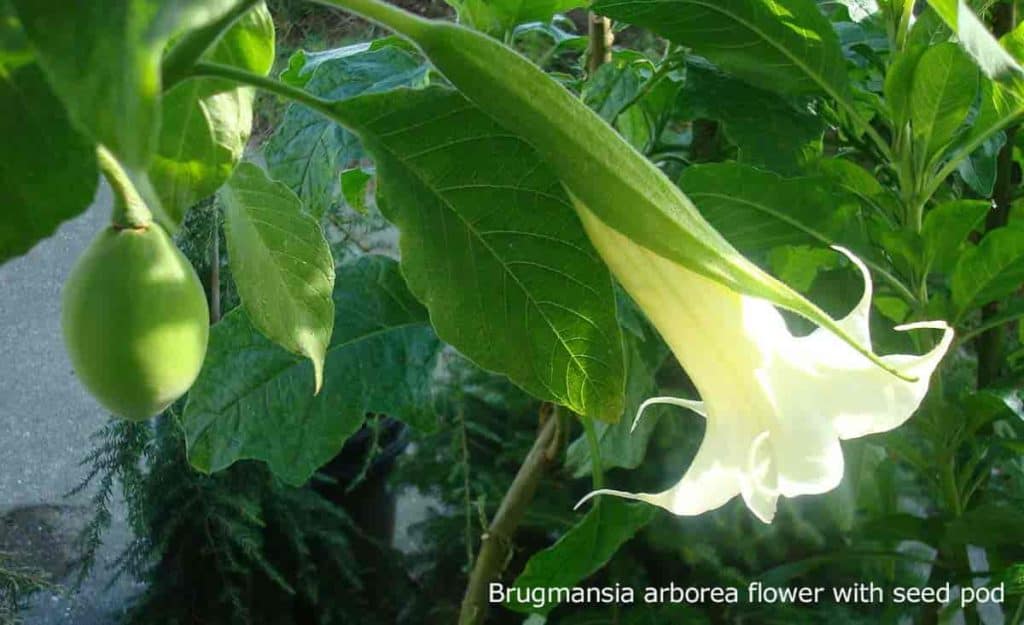 Brugmansia Arborea with seed pod – Image: Tom Hulse – Wikimedia.org
Brugmansia Arborea with seed pod – Image: Tom Hulse – Wikimedia.org
This variety comes from the Andes (Ecuador to northern Chile). It can take the form of a small evergreen tree or shrub when well-kept; however, left to its own devices, it can attain a height of 23′ feet. It has oval leaves with coarse, toothed margins and a fine, velvety down that also covers the stems, flower stalks, and fruit.
The flowers range in color from pure white to slightly creamy. They are deeply fragrant and range in size from about 5” to about 7” in length. They are the smallest of all Angel Trumpet blossoms.
Brugmansia Aurea
 Burgmansia Aurea – image: Kurt Stüber – Wikimedia.org
Burgmansia Aurea – image: Kurt Stüber – Wikimedia.org
From the South America Andes (Venezuela to Ecuador). This angel trumpet plant variety is sometimes called Golden Angel’s Trumpet. Until 2014, the golden angel is listed as being endangered in the wild, but it has since become extinct in the wild. This variety of Brugmansia can grow to be about 20′ feet tall. It produces fragrant white or yellowish blossoms.
Brugmansia Insignis
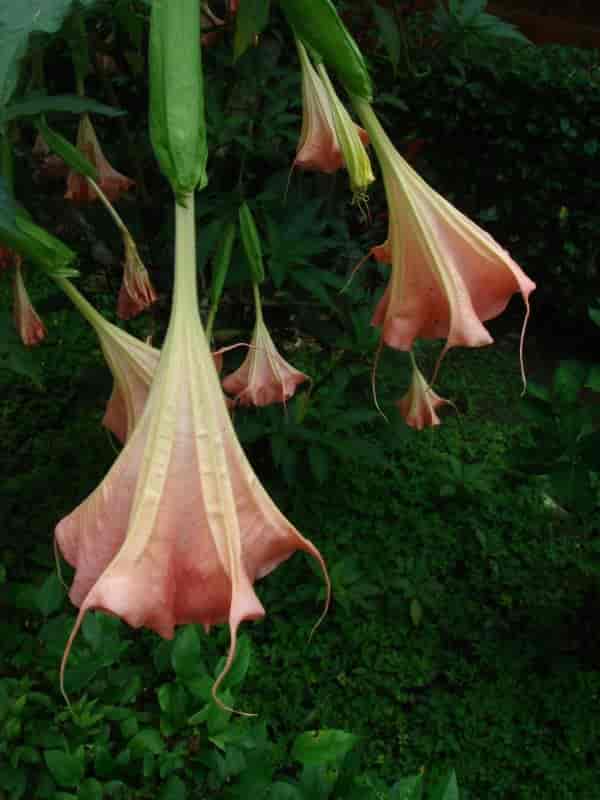 Brugmansia insignis – via wikimedia
Brugmansia insignis – via wikimedia
It comes from the foothills of the Eastern Andes (Brazil and Colombia to Bolivia). This is a smaller trumpet variety that reaches a maximum height of about 13 feet. Its narrow flowers come in both white and pink and are marked by attractive tendrils.
Brugmansia Sanguinea (Red Angel)
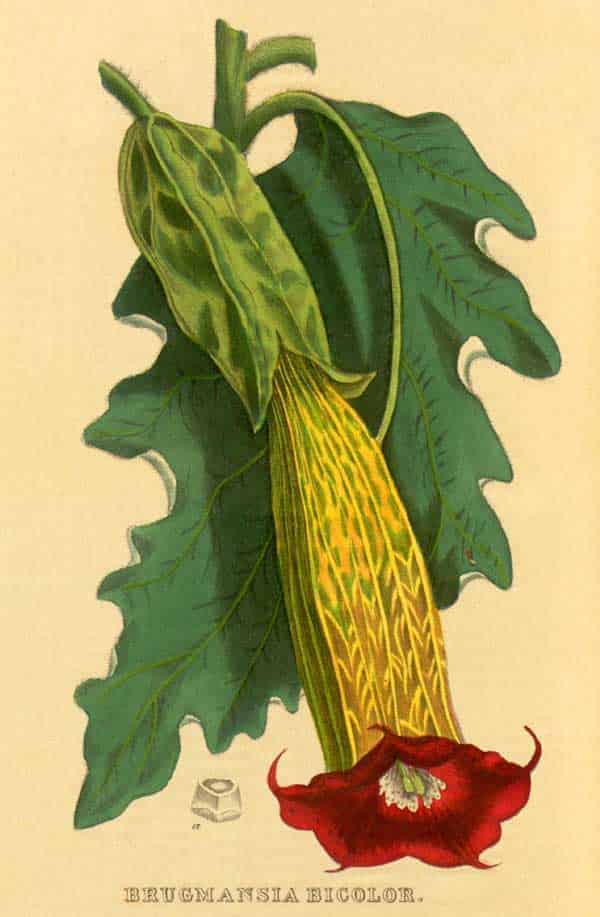 Brugmansia Sanguinea (bicolor) – image wikimedia.org
Brugmansia Sanguinea (bicolor) – image wikimedia.org
This angel trumpet plant type can be found from northern Chile to Columbia. This red variety is relatively odorless and blooms during the day. It uses its red color flowers to flowers to attract hummingbirds as pollinators. It also comes in other brilliant colors, such as green, orange, and yellow. This is a small bush with heights ranging between 4 feet and 12 feet.
Brugmansia Suaveolens
The brugmansia suaveolens type is a sweet, wild variety that grows in southeastern Brazil. This smallish variety (10’-16’) produces bounteous numbers of large, very fragrant white flowers that are sometimes called “angel’s tears.” The flowers can grow to be over a foot long and are sometimes seen in pale yellow or pink; however, white is the usual color.
Brugmansia Versicolor
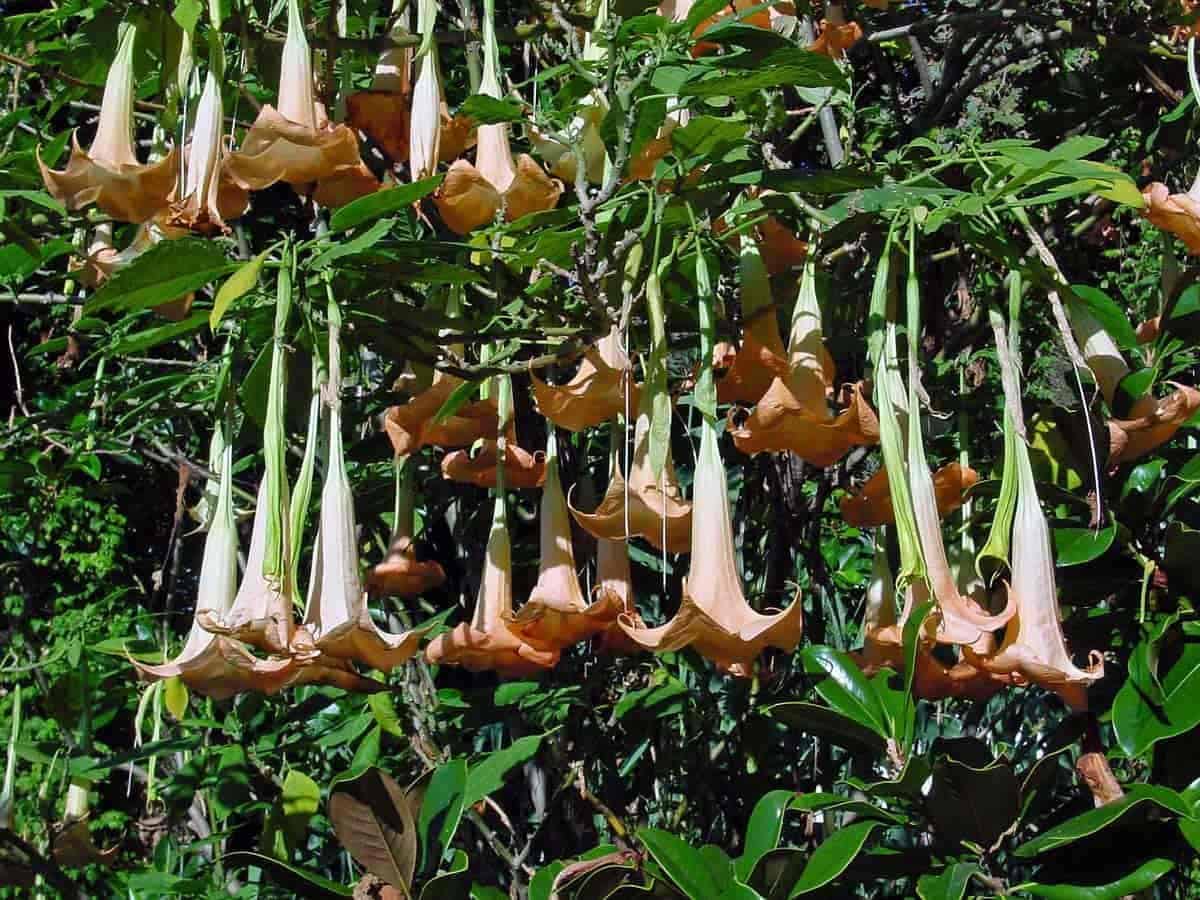 Brugmansia versicolor – image: Wouter Hagens via Wikimedia Commons
Brugmansia versicolor – image: Wouter Hagens via Wikimedia Commons
This smallish variety from Ecuador usually attains a height between 10 and 16 feet. The leaves are oblong with smooth edges. The giant flowers can attain a length of almost two feet. At first bloom, they are white, but sometimes they transition into shades of apricot, peach, or pink.
Brugmansia Vulcanicola
 Brugmansia Vulcanicola – Image via wikimedia
Brugmansia Vulcanicola – Image via wikimedia
This type of angel trumpet can be found in the Andes from Colombia to Ecuador. These small trees or shrubs attain a height of thirteen feet. They produce smallish (6”-9”) brightly colored flowers in shades of red, pink, and yellow.
In addition to these seven basics, there is an ever-increasing number of hybrids. Collectors can often boast having over two dozen different varieties. During the past two decades, many interesting traits have been developed, including creamy white edging on leaves of deep green, double blossoms, and variegated foliage.
What Is The Best Angel’s Trumpet Growing Zone?
Although these plants are only entirely hardy in USDA zones 9-12, they are quite popular throughout the United States.
Many people keep them in the far northern states and in Canada. In these settings, their season for growing is very short.
Winter care of Angel Trumpet plants depend greatly upon your setting. If you live in Canada or the northeastern United States, you must bring them indoors as houseplants or to go dormant.
Another option is to take cuttings to grow indoors in the wintertime. This will allow you to enjoy them as a small leafy houseplant through the winter and start fresh with all new plants in the springtime.
If you live in a climate that doesn’t freeze or only has light frosts, you can leave your Brugmansia outdoors year-round.
They do especially well in southwestern, coastal settings such as the coast of southern California, where they make up vast and gorgeous gardens in public parks and arboretums.
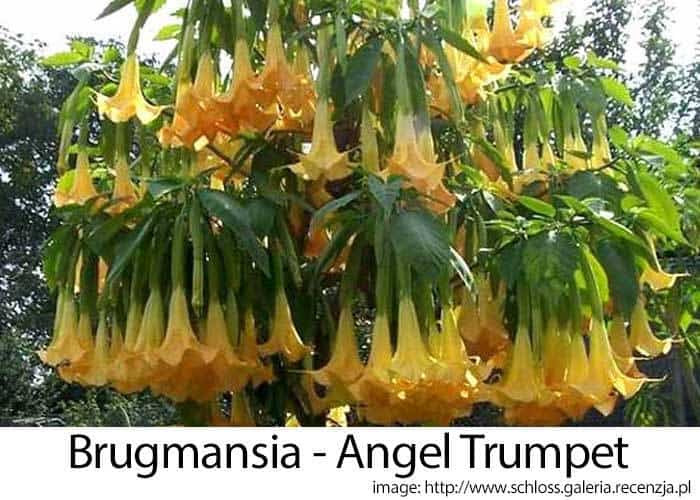
When Do Angel’s Trumpets Bloom?
In southwestern states and in the tropics, these enchanting shrubs produce richly fragrant blossoms throughout the spring, summer, and autumn.
In very cold climates, they will bloom through the two or three summer months when they are allowed outdoors. They do not typically bloom when kept indoors.
They tend to bloom in waves, so you may find that you have a tree full of blossoms for a few days, and then they will all fall at once. Take heart! Subsequent flushes will soon follow.
The blossoms are short-lived (one or two days). Trim them off promptly when they begin to fade to keep your bush or tree tidy and stimulate more blossoms.
Because these trees do tend to throw down a lot of spent blossoms, they can be considered a bit “trashy.” Keep blossoms swept off walkways for the best appearance.
You may wish to leave them in place in your garden angel trumpet bed, though. They decompose very quickly and feed the soil.
How To Prune Brugmansia Trees
There are several different ways to prune this plant depending upon the desired results. If you want a shrub-like plant, you can leave the lower limbs in place and trim the tips of the limbs to create a bushier effect.
If you want a tree, you should lop off the lower limbs completely as the plant grows. This is a task you must stay on top of because the plant will continue to try to send out low-growing branches no matter how tall it becomes.
In both instances, you can create a fuller and bushier appearance by trimming back half of the “Y” formation of the limbs.
As the plant sends out new limbs, you will see that each ends in a fork. Trim back the upper prong to cause thicker and more abundant growth.
These plants produce blooms on new wood, many continue to prune throughout the season.
Give a thorough pruning early in the springtime to shape the plant. Cut back old branches to about half-an-inch above growing nodes.
Watch your plant closely and trim it lightly and frequently to limit height, stimulate blooming, and encourage thicker, lusher growth.
In autumn, you can cut the plant back to a foot above the base before over-wintering.
Don’t worry about overdoing the pruning. Angel’s trumpet are rapid and enthusiastic growers.
Even if you buy a small potted plant, you can expect it to attain a height of six feet or more in its first year growing.
If you over-winter the plant, it will gain more and more height as the year progresses.
Even when brought indoors to winter in dormancy, the plants can reach a height of 12′ feet just in the span of a few warm months outdoors.
What’s The Best Way These Tropical Trees?
There are several ways to over-winter Angel’s trumpet. The method you choose may be dependent on a few factors including the amount of space, time, and physical strength you should contribute to the project.
Brugmansia are easy to find at garden centers and nurseries, and many people just treat them as annuals and replace them every year.
If this is not acceptable, here are four good ways to keep your Trumpets from year-to-year.
Keep Mature Plants In A Dormant State
While it is possible to keep a mature Brugmansia as a gigantic house plant in the winter, it is better to prune the mature plants back sharply, pot them closely, and allow them to go dormant in a cool basement or garage at temperatures ranging between 35° and 45° degrees Fahrenheit if you wish to keep mature plants from season-to-season.
It’s best to bring the plant in after the first frost but before the first freeze. When you do this, you will find the plant easier to work with because all the leaves and flowers will have dropped. You can cut the limbs back to about a foot high.
After pruning, dig up the plant and trim back the root ball to coincide with the size of the remaining limbs. Over-winter the plant in a container just big enough to accommodate the root ball.
Once you’ve placed your plant in its winter container, bring it indoors to a dark, cool place that keeps a constant temperature of 35 to 45 degrees Fahrenheit.
Water it occasionally throughout the winter. The potting soil should be just slightly damp. Never allow it to dry completely as this will kill your resting plant.
Keeping Huge Fragrant Flower Trumpets As A Giant House Plant
Begin by trimming your Brugmansia to a size and shape that will fit through your door. When you plan to keep your plant alive as a house plant or in a greenhouse through the winter, go for a tall, slim silhouette by cutting back most side branches and keeping two or three upright central branches.
Even with vigorous pruning, your Brugmansia will need a great deal of space, consistent heat, and plenty of light through the winter. It will need a large container to stay alive and do well.
Caring for Brugmansia indoors through the winter isn’t especially hard. Treat it like any indoor container plant by keeping it lightly watered and watching out for whiteflies and other typical indoor pests. Even so, bringing a huge plant indoors and living with it through the winter can be rather trying.
Before you embark on this massive undertaking, you should know that your plant is unlikely to bloom or thrive through the winter when kept like this. That’s why it is better to over-winter mature plants in a dormant state.
Over-Winter Your Trees Via Propagation
Collect cuttings 8″-12″ inches long for rooting purposes throughout the spring and the summer or at the end of the growing season.
Indeed, many people do this and start fresh new plants through the winter instead of bringing the parent plant indoors.
Cuttings grow into attractive house plants quickly, and these plants make lovely gifts at the holidays.
When you choose to sacrifice the parent and begin fresh with new plants grown from 8″-12″ inches long cuttings, you can enjoy your Brugmansia as a manageable houseplant through the winter and keep it on the smallish side through the growing season.
This method of carrying Trumpets forward from one year to the next also eliminates quite a bit of backbreaking labor.
There are so many easy options for propagation that you really needn’t be bothered with difficult digging and hauling these massive plants in-and-out-of-doors unless you simply can’t stand the thought of allowing the parent plants to die back over the winter.
Several Ways To Take Angel Trumpet Cuttings
You can get several “log cuttings” from a single limb. To do this, cut the limb into sections 8″-12″ inches long in length. Each section should have three or four nodes on it.
Using a plant rooting hormone dust (at Amazon) each cutting and plant it shallowly with the nodes facing upwards in pre-moistened soil in a plant saucer or tray.
Be sure to keep the cuttings at a temperature of about 72° degrees Fahrenheit. You can achieve this by covering your cuttings loosely with plastic wrap and/or making use of a heat mat. Monitor the temperature carefully as you don’t want your cuttings to get too hot.
If you think all of this sounds like too much trouble, take heart. While these careful preparations will surely yield excellent results, the fact is simply placing the cuttings in a sunny window in a consistently warm room may be all that’s needed.
New plants will sprout from each of the growing nodes. Once these are well under way, you can separate the log at intervals and repot your new plants into their own pots for the winter.
Keep them as houseplants at a consistently warm temperature with ample natural or artificial light. Because Angel’s are a tropical plant, it appreciates ample humidity. You can provide this by placing your potted plants on a layer of gravel in a tray with an inch or so of water. The water does not need to touch the bottom of the pots. Its purpose is to provide ambient humidity.
Place Cuttings In Jars or Vases of Water
You can also grow Brugmansia from cuttings by placing the cuttings in jars of water. You can do this with leafless cuttings or ones with foliage.
Be sure the cuttings you choose have nodes to produce new growth. Place the cuttings in a jar or vase of pure, filtered water in a warm, well-lit area. Change the water every few days to prevent rotting.
When your cuttings begin to grow roots, plant angel trumpets to a container of well-draining potting mix with a bit of granular fertilizer.
Try Air Layering
This interesting method of propagation allows you to save the top half of your parent plant while still reducing its size significantly. When you do this, you can bring the parent plant in for the winter, leaves and all, and cut its stump down to the ground outdoors.
Try covering the stump and surrounding area with a heavy layer of mulch through the winter. If you’re very lucky, the parent tree may grow back. If not, you’ll have a spare!
See this interesting video for detailed instructions on air-layering.
Growing Brugmanias From Seeds
If you don’t have access to young plants or cuttings, you have no choice but to grow from seed. This can be challenging because it can take a long time.
Brugmansia seeds can take from two weeks to several months to sprout, so if you don’t see results right away, don’t give up in despair.
To grow Brugmansia from seed, you would follow standard seed-sprouting protocol. Begin by soaking the seeds overnight in warm water to soften the outer hull and hopefully create a split that will help the seed sprout faster and with greater ease. [source]
Prepare a seed tray or small pots with pre-moistened, well-drained potting soil or seed-starting mix. When planting, take care not to bury the seeds deeply. They need exposure to light to germinate. You can either press them gently into the surface of light, airy soil or cover them very lightly.
Sow the seeds indoors early in the springtime. Cover the trays or pots with plastic wrap and keep them in a warm (65°-70° degrees Fahrenheit) place with good natural or artificial light. Keep them carefully at temperatures of 60°-70° degrees Fahrenheit.
Germination should take 2-4 weeks, but sometimes it takes much longer. If all goes well, you should see results in a couple of weeks, but remember to be patient.
Months could elapse before your plants emerge. Just keep your hopeful plants warm and provide them ample light and consistent moisture.
Growing Brugmansia from Seed – Angel’s Trumpet
Is It Better To Grow Angel’s Trumpet From Seeds Or Cuttings?
It is quicker and easier to grow Angel Trumpet flower tree from cuttings. Although these plants are extinct in the wild, the fact is Mother Nature has equipped them to naturalize and spread quickly and easily. They are vigorous growers and send out masses of adventurous roots.
When you prune your Brugmansia, you can grow multiple new plants from each limb you cut off. Whether you simply stick the cut limb into a container of well-drained potting mix or put it in a jar of water, roots will begin to grow within a couple of weeks.
If you throw your Brugmansia cuttings into your compost heap, you are likely to see new plants springing up shortly if the weather stays warm.
Preparing Your Trumpets To Go Outdoors In the Springtime
No matter how you keep your Brugmansia through the winter, you will want to transplant it carefully and reduce transplanting shock to outdoor living in the spring.
A few weeks before all danger of frost has passed, you can begin getting your Brugmansia ready to go outdoors.
Transition it gradually to going back outdoors. A few weeks before the last frost, you’ll want to repot your Brugmansia and move it into a warm area with good natural or artificial lighting. Increase watering gradually.
If you have kept a mature plant in dormancy, it may look dead when you retrieve it from its resting place. But if you look closely, you will surely see some small, pale green shoots at its base.
The stems will have died back some over the winter. Scrape the stems gently with a sharp knife blade in a few locations to locate green growth underneath. Trim off dead branch ends as needed.
When you unpot your Angel’s Trumpet Brugmansia after winter storage, you are sure to find it root bound, but don’t let that worry you. Massage the roots with your fingers to loosen them up.
Trim off excess roots and repot your Angel’s trumpet in rich, fresh, well-drained potting soil with plenty of water and balanced granular fertilizer. Place your repotted plant in a warm, sunny area of your home to begin its recovery.
Once your plant has started growing, after dormancy, remember to fertilize weekly. A balanced, fish-based liquid fertilizer is a good choice.
No matter how you have kept your Angel’s trumpet through the winter, as the weather warms up, allow your plants to sit outdoors in the sunshine for a few hours at a time over a period of several weeks before transplanting them to your garden or setting their pots in their summertime locations.
Watering & Fertilizing Angel Trumpets
Angel’s Trumpet Brugmansia plants are thirsty, hungry plants. Keep the root ball evenly moist throughout while growing outdoors.
Water over-wintering plants lightly about once a week while dormant.
Check houseplants frequently. Keep the soil barely moist or damp. As with all houseplants, you don’t want to over-water because this may cause root rot, but you should not allow the soil to become dry between watering. This is very hard on Angel Flower and may kill them.
Water outdoor plants regularly. If it is extremely hot and dry where you live, you may need to water every day. One way to help your plant retain water is to sink its pot into your garden soil. Alternately, you may wish to sink it into a larger container of soil. This provides it some insulation and prevents rapid evaporation.
What Is the Best Fertilizer For Flowering Trumpets?
Angel Trumpets are heavy feeders. Producing masses of large, showy, highly scented flowers consumes huge amounts of nitrogen. You can use a standard balanced slow-release fertilizer for flowering plants on Brugmansia, but you must apply it very generously.
Be sure to plant using a well-draining potting soil rich in mature organic compost. Fertilize weekly with a liquid 20-20-20 water-soluble fertilizer, or apply a top-dressing of dry fertilizer weekly.
If you are anxious about over-fertilizing, you can simply use rich compost or choose a balanced fertilizer for flowering plants, and follow the instructions on the package. Most successful Angel’s trumpet growers say that these plants need about twice the amount of fertilizer required by other types of flowering tropical plants.
The difference between Angel’s Trumpet Brugmansia that gets standard fertilization and one that gets ample fertilization is apparent. These tough plants can survive well on standard fertilization, but they will not thrive and bloom abundantly. Look into this Brugmansia, Datura (Angel’s Trumpets) Liquid Fertilizer.
Pests And Diseases
Snails & Slugs
Seedlings and new growth are subject to predation by slugs and snails. Sprinkle the ground around tender young Angel’s Trumpets with diatomaceous earth on a regular basis to discourage soft-bodied slug and snail garden pests and provide a little boost of calcium and silica.
Spider Mites
When kept indoors, Angel’s trumpet are subject to infestation by spider mites. To prevent this, be sure to wash plants or cuttings with insecticidal soap and rinse them clean before bringing them indoors. Keep an eye on them and treat them as needed indoors to keep these pests under control. While they may also cause a problem outdoors, it is less likely.
Caterpillars
Some caterpillars eat Angel’s trumpet because they can convert the plant’s poisonous alkaloids into a natural defense mechanism to repel predators.
Naturally, you do not want caterpillars eating leaves on your Angel’s Trumpets, but you also don’t want to kill off potential butterflies.
Planting a butterfly garden nearby and perhaps equipping it with a few cast-off Brugmansia may help solve your problem.
Just pick the caterpillars off by hand and relocate them when you see them or try using bacillus thuringiensis (bt).
Where To Keep Your Brugmansia For The Most Enjoyment
Angel’s trumpet do well in a sheltered setting with ample sun and fertile, well-drained soil. It likes a slightly acidic soil, so be sure to strive for a pH level of 6.5-7.
These semi-tropical plants like full sun; however, if you live in a hot, dry, desert area, partial shade is appreciated. Steady, dappled sunlight is beneficial, so they do well when planted as an understory for taller trees.
Remember that all but one variety of Angel’s trumpet blooms at night, so be sure to place your plants in a location that will allow you to enjoy them to the fullest.
Placing your plants on a patio and/or near windows that will be open at night allows their delicious fragrance to waft into your home.
 Brugmansia Arborea with seed pod – Image: Tom Hulse – Wikimedia.org
Brugmansia Arborea with seed pod – Image: Tom Hulse – Wikimedia.org Burgmansia Aurea – image: Kurt Stüber – Wikimedia.org
Burgmansia Aurea – image: Kurt Stüber – Wikimedia.org Brugmansia insignis – via wikimedia
Brugmansia insignis – via wikimedia Brugmansia Sanguinea (bicolor) – image wikimedia.org
Brugmansia Sanguinea (bicolor) – image wikimedia.org Brugmansia versicolor – image: Wouter Hagens via Wikimedia Commons
Brugmansia versicolor – image: Wouter Hagens via Wikimedia Commons Brugmansia Vulcanicola – Image via wikimedia
Brugmansia Vulcanicola – Image via wikimedia